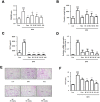Baicalin alleviates benign prostate hyperplasia through androgen-dependent apoptosis
- PMID: 32018227
- PMCID: PMC7041748
- DOI: 10.18632/aging.102731
Baicalin alleviates benign prostate hyperplasia through androgen-dependent apoptosis
Abstract
BPH is a disease prevalent among elderly men that is characterized by abnormal proliferation of prostatic epithelial and stromal tissues. No effective treatment exists for BPH owing to lack of a clear understanding of its molecular etiology. Although several studies have reported therapeutic effects of baicalin against numerous diseases, including prostate cancer, its beneficial effects on BPH have not yet been explored. The present study investigated the therapeutic effects of baicalin on the development of BPH and its mechanism of action. We established a testosterone-treated BPH animal model and DHT-stimulated prostate cell lines, including RWPE-1 and WPMY-1. Administration of baicalin ameliorated the pathological prostate enlargement, suppressed the production of DHT, and inhibited the activity of 5α- reductase Type II in the animal model. BC exerted these effects via its anti-proliferative effects by restoring the Bax/Bcl-2 ratio, activating caspase-3 and caspase-8, and inducing the phosphorylation of AMPK. In vitro studies using DHT-stimulated prostate cells demonstrated an up-regulation of BPH-related and proliferation markers, whereas baicalin clearly reduced the overexpression of AR, PSA, PCNA, and Bcl-2. These results suggested that baicalin could suppress androgen-dependent development of BPH both in vivo and in vitro by inducing apoptosis.
Keywords: androgen; apoptosis; baicalin; benign prostatic hyperplasia; proliferation.
Conflict of interest statement
Figures






Similar articles
-
Psoralea corylifolia L. extract ameliorates benign prostatic hyperplasia by regulating prostate cell proliferation and apoptosis.J Ethnopharmacol. 2021 Jun 12;273:113844. doi: 10.1016/j.jep.2021.113844. Epub 2021 Jan 21. J Ethnopharmacol. 2021. PMID: 33485982
-
Quisqualis indica Improves Benign Prostatic Hyperplasia by Regulating Prostate Cell Proliferation and Apoptosis.Biol Pharm Bull. 2017 Dec 1;40(12):2125-2133. doi: 10.1248/bpb.b17-00468. Epub 2017 Sep 22. Biol Pharm Bull. 2017. PMID: 28943529
-
Cynanchum wilfordii Ameliorates Testosterone-Induced Benign Prostatic Hyperplasia by Regulating 5α-Reductase and Androgen Receptor Activities in a Rat Model.Nutrients. 2017 Sep 27;9(10):1070. doi: 10.3390/nu9101070. Nutrients. 2017. PMID: 28953224 Free PMC article.
-
Dihydrotestosterone and the concept of 5alpha-reductase inhibition in human benign prostatic hyperplasia.World J Urol. 2002 Apr;19(6):413-25. doi: 10.1007/s00345-002-0248-5. World J Urol. 2002. PMID: 12022710 Review.
-
5alpha-reductase activity in the prostate.Urology. 2001 Dec;58(6 Suppl 1):17-24; discussion 24. doi: 10.1016/s0090-4295(01)01299-7. Urology. 2001. PMID: 11750244 Review.
Cited by
-
Oral administration of berberine represses macrophage activation-associated benign prostatic hyperplasia: a pivotal involvement of the NF-κB.Aging (Albany NY). 2021 Aug 19;13(16):20016-20028. doi: 10.18632/aging.203434. Epub 2021 Aug 19. Aging (Albany NY). 2021. PMID: 34411001 Free PMC article.
-
Black phosphorus nanosheets encapsulated microneedle for multifunctional therapy for androgenic alopecia.J Nanobiotechnology. 2025 Feb 27;23(1):147. doi: 10.1186/s12951-025-03242-z. J Nanobiotechnology. 2025. PMID: 40016758 Free PMC article.
-
Chemopreventive Potential of Paddy Waste: A Promising Approach Against Benign Prostate Hyperplasia in Spontaneously Hypertensive Rats.Anal Cell Pathol (Amst). 2025 Mar 13;2025:4029625. doi: 10.1155/ancp/4029625. eCollection 2025. Anal Cell Pathol (Amst). 2025. PMID: 40115867 Free PMC article.
-
NOSTRIN is involved in benign prostatic hyperplasia via inhibition of proliferation, oxidative stress, and inflammation in prostate epithelial cells.Transl Androl Urol. 2024 Sep 30;13(9):2055-2069. doi: 10.21037/tau-24-209. Epub 2024 Sep 24. Transl Androl Urol. 2024. PMID: 39434759 Free PMC article.
-
Antitumor Activity In Vivo and Vitro of New Chiral Derivatives of Baicalin and Induced Apoptosis via the PI3K/Akt Signaling Pathway.Mol Ther Oncolytics. 2020 Sep 1;19:67-78. doi: 10.1016/j.omto.2020.08.018. eCollection 2020 Dec 16. Mol Ther Oncolytics. 2020. PMID: 33072864 Free PMC article.
References
Publication types
MeSH terms
Substances
LinkOut - more resources
Full Text Sources
Medical
Research Materials
Miscellaneous

